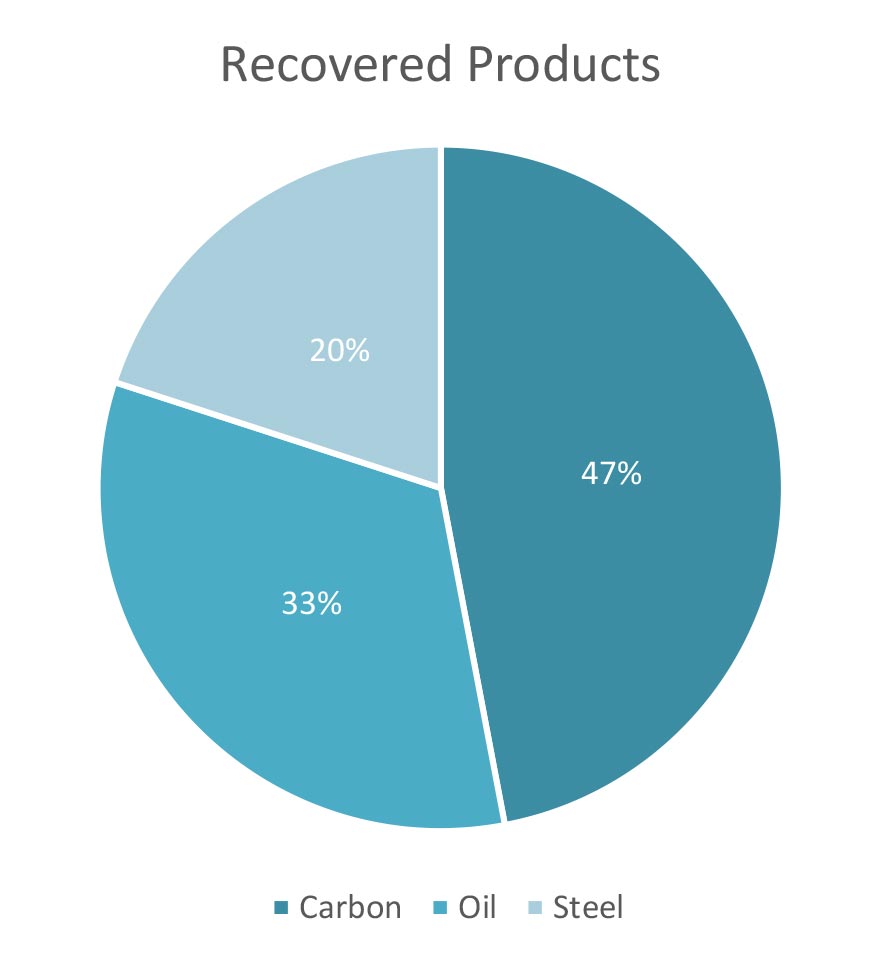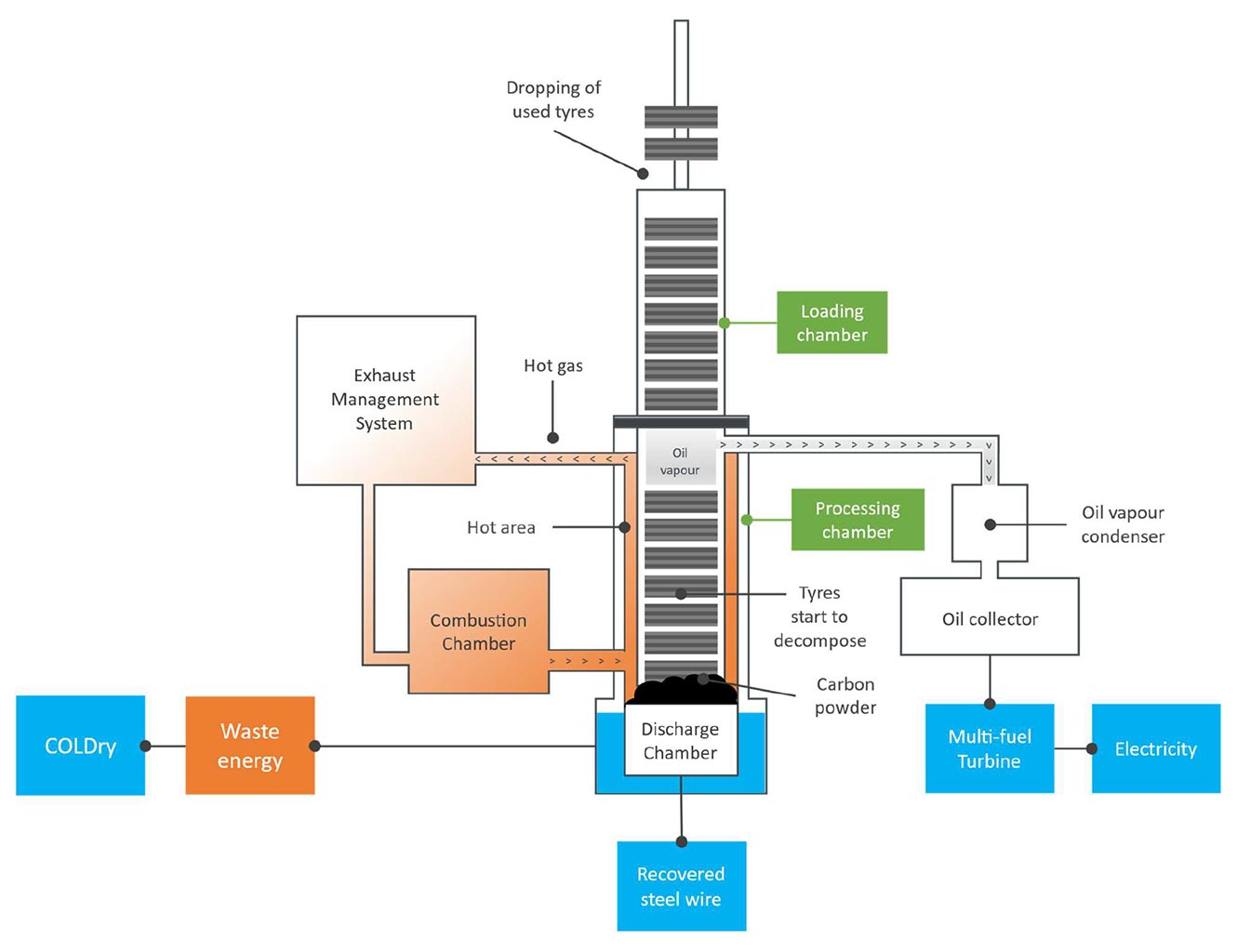The following is a media release from Environmental Clean Technologies Limited (ASX: ECT).
ECT and GDT have signed a Memorandum of Understanding to create a commercial grade end-of-life tyre resource recovery plant at Bacchus Marsh in Victoria.
Highlights:
- MoU signed with Green Distillation Technologies (GDT) to collaborate on the deployment of a commercial end-of-life tyres (EOLT) resource recovery facility at ECT’s site at Bacchus Marsh.
- Targeting integration opportunities with:
- COLDry for waste heat recovery and utilisation
- Oil production acting as feedstock for electricity turbine
- Refined products from tyres include fuel oil, solid carbon and recovered steel.
Building partnerships for a fully integrated “Waste to Clean Energy Hub” that bring investment, capability, and process synergies to both the Bacchus Marsh and Latrobe Valley projects.
19 May 2022: Environmental Clean Technologies Limited (ASX: ECT) (“ECT” or “Company”) is pleased to announce the signing of a Memorandum of Understanding (MoU) with Green Distillation Technologies Limited (GDT) for the development of a collaborative project which could lead to the deployment of GDT’s proprietary technology at ECT’s site in Bacchus Marsh, northwest of Melbourne.
ECT recently announced(1) the recommencement of Phase 2 of its COLDry upgrade project at Bacchus Marsh (“Bacchus Marsh Project”), aimed at delivering an integrated small scale commercial demonstration of its Net Zero Emission Hydrogen Refinery planned for the Latrobe Valley (“Latrobe Valley Project”). In the same announcement, the Company outlined its intent to develop a fully integrated ‘waste-to-clean energy hub’ at its Bacchus Marsh site, complementing the Net Zero Emission Hydrogen Refinery demonstration.
In delivering on this strategy, ECT has identified partnerships that it believes will support the long-term sustainability and development of the Bacchus Marsh facility. ECT Managing Director Glenn Fozard commented:
We continue to focus on those commercial partnerships that can assist our company deliver on both the Bacchus Marsh and Latrobe Valley projects. We are targeting those opportunities that can improve our delivery timeframe, broaden the depth of our technical integration and expertise both upstream and downstream, and provide access to critical energy, waste and carbon markets. The current GDT opportunity fits well in this profile with both expanded market opportunity and direct integration with our COLDry technology process.
GDT, led by John Fletcher(2) and Trevor Bayley, has developed a process called ‘destructive distillation’ that effectively deals with one of the most significant and challenging waste issues; end-of-life tyre (EOLT) processing and resource recovery.
(1)See ASX Announcement dated 28 April 2022: “Joint Venture Agreement with GrapheneX for Demonstration Project and Capital Raising”
(2)John Fletcher: Former Brambles CEO (1993-2001) & former Coles Group CEO (2001-2007)
GDT Chairman John Fletcher commented:
There is a rapidly growing waste stream of end-of-life tyres in Australia, with over 26 million units generated each year.
With export of whole baled tyres now banned by the Federal Government, and hefty ‘gate fees’ for landfill, domestic processing capacity must be increased.
GDT’s technology is a timely solution to one of Australia’s significant waste issues. Operating under a carbon-negative footprint and delivering commodities that supplement, substitute or replace fossil derived products.”
The non-binding MoU brings ECT and GDT together to investigate the potential development of GDT’s first Victorian plant at ECT’s Bacchus Marsh site. The Company notes that the MoU is non-binding and it is possible that a partnership may not eventuate.
Most importantly, the parties will explore the opportunities for integration between the technology platforms of each company in support of a net-zero emission waste to energy hub, which may lead to a direct investment into GDT by ECT.
Of particular interest is the opportunity to harvest waste heat via integration of COLDry’s drying system with the discharge chamber of GDT’s process (see diagram below).
ECT will provide access to its technology, process, engineering, and R&D resources. GDT will contribute its technology, project and development knowledge and suite of partners.
Trevor Bayley, Director at GDT, commented:
Destructive Distillation, as GDT’s technology is known, is unique in several aspects, from the feedstock of whole tyres to the high-quality, stable oil and the clean steel wire.
Moreover, the obvious synergies with ECT make this an exciting proposition for both of us. All the products from our process need to be cooled to ambient temperature for collection and sale. The energy released is ideal for collection and consumption within the COLDry process to support drying operations
The material terms and activities under the MoU will include:
- Assessment of ECT’s site for suitability to establish a commercial scale EOLT facility
- Scoping of utility requirements
- Review of EPA and planning permit requirements
- Logistics plan
- Identification of integration opportunities with ECT’s COLDry process for waste heat recovery and utilisation
- Techno-economic feasibility study and investment proposal
- GDT and the Company agree to share the costs of external service providers in carrying out the above activities
- The termination date for the MoU is 30 June 2023.
Reclaim. Reuse. Recycle.

The GDT process contributes to the circular economy, breaking the tyres down into solid carbon (47%), recovered oil (33%) and steel (20%).
The carbon product is the residue of ‘carbon black’ used in the tyre manufacturing process – an additive that strengthens the rubber and makes it more durable. The recovered carbon (rCB) can be used in a wide range of applications, from rubber additive to asphalt modifier and many in between. Further R&D will also be undertaken to determine approaches to higher-value markets.
The oil produced would be suitable as one of the fuels for the multi-fuel turbine to be installed under Phase 2 of the Bacchus Marsh Project. Producing the oil on-site has logistics benefits expected to result in lower-cost fuel for electricity generation. Further, the oil could be stored and used at select times at higher rates to take advantage of peak electricity pricing during ‘shoulder periods’ in the morning and evening.
The steel comes from the wire used to build and reinforce the tyres and can be directed to the scrap markets for recovery via electric arc, induction or blast furnace recycling.
Diagram – GDT’s End of Life Tyre Process

ECT Chairman Jason Marinko commented:
Establishing partnerships like this one further underpins the ongoing commercial life of the Bacchus Marsh Project beyond the demonstration of ECT’s technology. It also showcases ECT’s role in supporting conventional industries’ zero net emissions transition in recycling, energy and minerals recovery and how COLDry plays a part in this.
Notwithstanding the planning and preparations outlined in this MOU with GDT, the Company maintains the completion of Phase 1 (COLDry) and the planning, design and construction of Phase 2 (Syngas and char production and refinement into hydrogen derivatives) as the core priorities of the business.
This announcement was approved for release by the Board of the Company.
For further information, please contact:
INVESTORS
Glenn Fozard
Managing Director
info@ectltd.com.au / +613 9849 6203
MEDIA
Adam Giles
Marketing & Communications Manager
media@ectltd.com.au / +613 9849 6203
About ECT
ECT has been developing net-zero emission and hydrogen technologies for over 15 years.
Our solutions aim to transition today’s use of resources to tomorrow’s zero-emission future, delivering immediate financial and environmental benefits.
We are focused on advancing a portfolio of technologies with significant market potential globally.
ECT’s business plan is currently focusing on two major projects:
- Zero-Net Emission COLDry Commercial Demonstration at Bacchus Marsh, Victoria, Australia
- Zero-Net Emission Hydrogen Refinery Project at the Latrobe Valley, Victoria, Australia
About the ECT Technology Suite
COLDry
COLDry is the gateway enabler of higher-value applications for waste biomass and lignite.
These streams are a rich source of valuable hydrocarbons. However, they suffer from high moisture content that must be reduced to enable higher value upgrading and conversion to solid fuels, liquid or gaseous hydrocarbons.
Drying is easy. However, drying efficiently, cost-effectively and with a low emissions footprint has been the challenge. COLDry meets this challenge through a combination of ‘substrate densification’ and waste heat utilisation, delivering the world’s first low temperature, low pressure, low cost, zero CO2 emissions drying process.
HydroMOR
The HydroMOR process has the potential to revolutionise primary iron making.
HydroMOR is a simple, low cost, low emission, hydrogen-driven technology that enables ‘low value’ feedstocks to produce primary iron. HydroMOR is the transition solution to a “green steel” future.
COHgen
The COHgen process has the potential to deliver a lower cost, lower emission method for hydrogen production from lignite and other waste biomass streams.
COHgen is currently advancing through fundamental laboratory development intended to form the basis for a patent application ahead of scale-up and commercialisation.
COHgen aims to decouple hydrogen production from CCS, accelerating the race towards <$2kg production costs with little to no emissions.
CDP-WTE
The catalytic depolymerisation-based waste-to-energy process converts low-value resources into higher-value diesel and other valuable by-products.
CDP-WTE can be deployed as a standalone solution or integrated with the COLDry process to deliver higher-value, lower-emission energy solutions to lignite resource owners.
Forward-Looking Statements
Statements contained in this release, particularly those regarding possible or assumed future performance, revenue, costs, dividends, production levels or rates, prices or potential growth of ECT, are or may be, forward-looking statements. Such statements relate to future events and expectations and, as such, involve known and unknown risks and uncertainties. Therefore, actual results and developments may differ materially from those expressed or implied by these forward-looking statements depending on a variety of factors.



